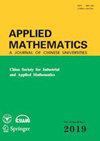l1−2模型的分组效应
IF 1
4区 数学
Applied Mathematics-A Journal of Chinese Universities Series B
Pub Date : 2022-09-20
DOI:10.1007/s11766-022-4256-5
引用次数: 0
摘要
本文旨在研究具有相关列的测量矩阵的l1−2模型的数学性质。我们首先证明l1−2模型满足分组效应,确保测量矩阵中高度相关列对应的系数差异很小。然后给出了基于稀疏逼近性质的稳定性分析。当向量的条目具有不同的符号时,我们证明了线性化Bregman迭代所涉及的约束l1+2最小化模型也具有分组效应。本文章由计算机程序翻译,如有差异,请以英文原文为准。
On the grouping effect of the l1−2 models
This paper aims to study the mathematical properties of the l1−2 models that employ measurement matrices with correlated columns. We first show that the l1−2 model satisfies the grouping effect which ensures that coefficients corresponding to highly correlated columns in a measurement matrix have small differences. Then we provide the stability analysis based on the sparse approximation property. When the entries of the vectors have different signs, we show that the grouping effect also holds for the constraint l1+2 minimization model which is implicated by the linearized Bregman iteration.
求助全文
通过发布文献求助,成功后即可免费获取论文全文。
去求助
来源期刊

Applied Mathematics-A Journal of Chinese Universities Series B
MATHEMATICS, APPLIED-
自引率
10.00%
发文量
33
期刊介绍:
Applied Mathematics promotes the integration of mathematics with other scientific disciplines, expanding its fields of study and promoting the development of relevant interdisciplinary subjects.
The journal mainly publishes original research papers that apply mathematical concepts, theories and methods to other subjects such as physics, chemistry, biology, information science, energy, environmental science, economics, and finance. In addition, it also reports the latest developments and trends in which mathematics interacts with other disciplines. Readers include professors and students, professionals in applied mathematics, and engineers at research institutes and in industry.
Applied Mathematics - A Journal of Chinese Universities has been an English-language quarterly since 1993. The English edition, abbreviated as Series B, has different contents than this Chinese edition, Series A.
 求助内容:
求助内容: 应助结果提醒方式:
应助结果提醒方式:


